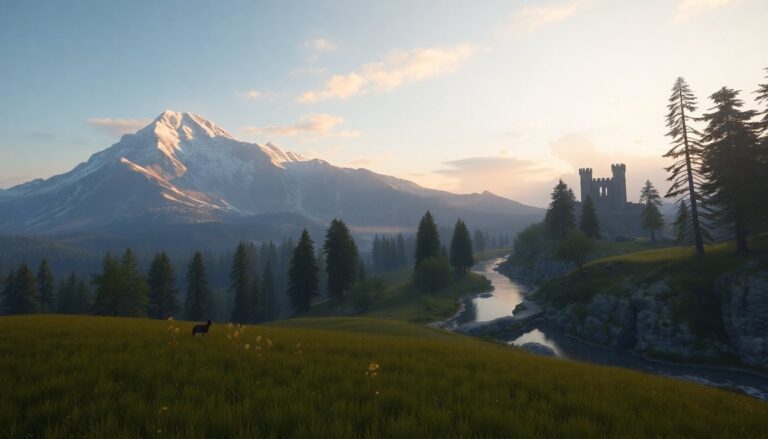Argomenti trattati
In the dynamic realm of video gaming, open-world games distinguish themselves as a genre that enthralls players with expansive environments and unmatched freedom. Unlike linear games, where players follow a set path, open-world titles empower players to explore vast landscapes, engage in diverse activities, and shape their own narratives. This article examines the evolution of open-world games, their distinctive features, and the factors contributing to their widespread appeal.
The Evolution of Open-World Games
The origins of open-world gaming can be traced back to early titles that introduced elements of exploration and autonomy. Games such as Adventure on the Atari 2600 and Zelda on the NES established a foundation by providing players with a non-linear experience. However, it was the advent of 3D graphics that truly transformed the genre.
The Evolution of Open-World Gaming
In the late 1990s, Grand Theft Auto III marked a significant milestone in the gaming industry. This title introduced a detailed, immersive city that players could explore at their leisure. It not only set the standard for open-world design but also introduced complex narratives and character development. These elements would become staples in future titles.
The Role of Technology
As technology advanced, so too did the capabilities of open-world games. The introduction of more powerful gaming consoles and PCs enabled developers to create richer, more detailed worlds. Titles like The Elder Scrolls V: Skyrim and Red Dead Redemption 2 exemplify this evolution. They offer players breathtaking visuals and intricate environments filled with quests, NPCs, and lore.
Key Features of Open-World Games
Open-world games are distinguished by their emphasis on player choice and freedom. Gamers can decide how to approach various challenges, opting to follow the main storyline or explore side quests and hidden secrets. This level of autonomy fosters a strong sense of ownership over the gaming experience.
Another essential characteristic is the dynamic game world. In many open-world titles, player actions can influence both the environment and the narrative. For example, in Fallout 4, decisions made by players can determine the fate of entire factions, clearly demonstrating the impact of player agency.
Immersion and Realism
Open-world games are designed to achieve a high level of realism. They often employ techniques such as procedural generation to create varied landscapes and ecosystems. This method enhances immersion, as players encounter unique experiences with each session. For example, games like Minecraft utilize procedural generation to create limitless worlds, enabling players to forge their own paths and craft their unique adventures.
The Appeal of Open-World Games
The allure of open-world games is multifaceted. Players are attracted by the freedom these games offer, which allows for personalized experiences tailored to individual playstyles. Whether one prefers combat, exploration, crafting, or storytelling, open-world games provide a versatile platform to engage with various gameplay elements.
The Allure of Open-World Games
The sense of discovery inherent in open-world games captivates players. The thrill of uncovering hidden treasures, secret locations, or unexpected encounters keeps players engaged. This engagement often leads them to invest countless hours into their virtual adventures. Titles like The Legend of Zelda: Breath of the Wild exemplify this phenomenon. Players explore a vast landscape filled with surprises and challenges, enhancing their gaming experience.
The Community Aspect
Another key factor in the popularity of open-world games is the vibrant communities that form around them. Players frequently share tips, strategies, and creative approaches to experiencing these expansive worlds on platforms like Reddit and YouTube. This communal sharing significantly enriches the overall experience, allowing players to learn from one another and deepen their engagement with the game.
The Future of Open-World Gaming
As we look to the future, the evolution of open-world games seems promising. With ongoing advancements in technology, developers are poised to redefine the limits of world-building and player interaction. Technologies such as virtual reality (VR) and augmented reality (AR) have the potential to transform player engagement, creating experiences that are increasingly immersive and interactive.
Moreover, the incorporation of artificial intelligence and machine learning is likely to yield more responsive non-player characters (NPCs) and dynamic storylines, further enriching the gaming experience. As these technologies progress, they will unlock new possibilities for innovative storytelling and gameplay mechanics within the realm of open-world games.
The Evolution of Open-World Gaming
In conclusion, the open-world genre has significantly reshaped the gaming landscape. It provides players with a unique combination of freedom and immersion. This genre boasts a rich history and engaging gameplay mechanics that have evolved over time. As technology advances, the potential for open-world games continues to expand. Players can expect to see even more innovative experiences that will captivate audiences globally.

